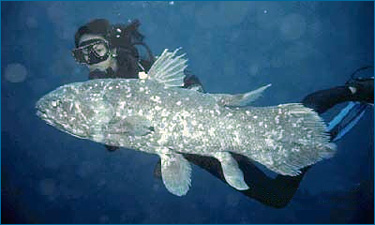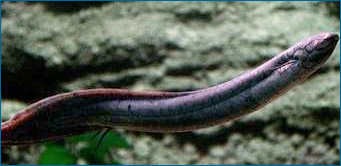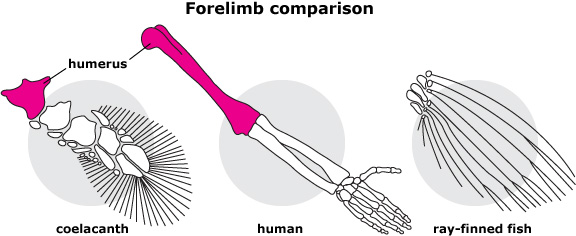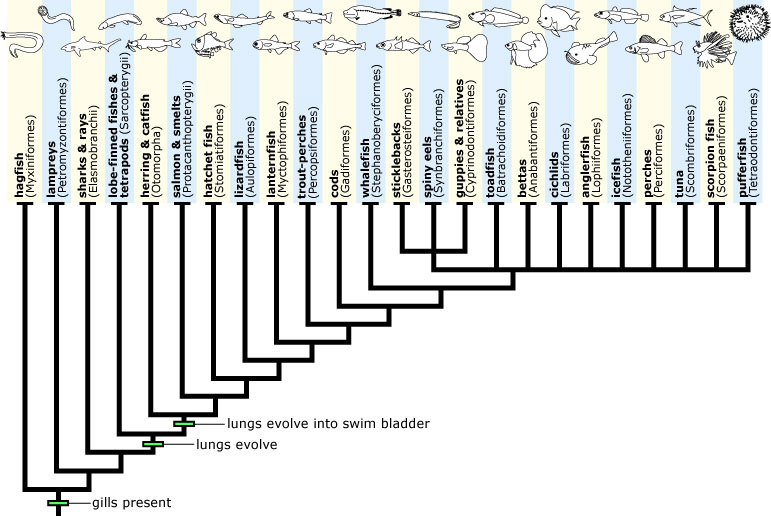
In 1938, a South African fisherman pulled a strange catch from the waters of the Indian Ocean. The iridescent blue animal had oddly fleshy fins that looked something like limbs. Scientists had seen fish like it before — but only preserved as fossils in ancient rocks. The fish was a coelacanth (SEE-luh-kanth), a member of the clade Sarcopterygii (sar-KOP-tuh-RIJ-ee-eye), and was thought to have gone extinct 80 million years ago!
Like other sarcopterygians, the coelacanth has “lobe-fins,” muscular fins with a single bone that articulates with the rest of the body. Most fishes (the Actinopterygii, or ray-finned fishes) have several bones at the bases of their pectoral fins, and their fins are composed of a set of webbed rays, not muscle- and skin-covered bone.

Lobe fins are rare among living fish and are only possessed by the coelacanth and lungfish. However, lobe limbs are possessed by many living organisms — including humans. That’s because we, and in fact all tetrapods (four-limbed vertebrates, many of which live on land), share a more recent common ancestor with the coelacanth and lungfish than we do with ray-finned fishes. We tetrapods are sarcopterygians too!
Tetrapods evolved from a group of organisms that, if they were alive today, we would call fish. They were aquatic and had scales and fleshy fins. However, they also had lungs that they used to breathe oxygen. Between 390 and 360 million years ago, the descendents of these organisms began to live in shallower waters, and eventually moved to land. As they did, they experienced natural selection that shaped many adaptations for a terrestrial way of life. Like other terrestrial sarcopterygians, modern humans still carry the evidence of our aquatic past in the way our arms and legs attach to our bodies, as well as in the many other features that link us to our fishy origins.

Which came first, the gill or the lung?
Since fish appear in the fossil record earlier than the clade we call tetrapods does, it’s tempting to assume that modern fishes bear the same traits that their and our common ancestor did. This line of reasoning is intuitive, but it is not correct. Though it is true that both modern ray-finned fishes and the ancestor we tetrapods have in common with them are finned and aquatic, the same pattern of reasoning does not hold water when it comes to lungs.
The available evidence suggests that gills were present in the very earliest fishes — the common ancestor of hagfish and ray-finned fishes. However, lungs — gas-filled organs that serve the function of respiration — also evolved very early on. The common ancestor of the lobe- and ray-finned fishes had lungs as well as gills. So what happened to these lungs and gills? In the lobefins, lungs stuck around, and tetrapods, coelacanths, and (duh) lungfish, all inherited them and use them to obtain oxygen. Coelacanths and lungfish also retained their gills. Modern tetrapods, on the other hand, bear evidence indicating that we once had gills but that these were lost in the course of our early evolution. The ray-finned fishes retained gills, and some of them (e.g., the bichirs, BYK-heerz) also retained lungs for the long haul. But in the lineage that wound up spawning most ray-fins (and in at least one other lineage), lungs evolved into the swimbladder — a gas-filled organ that helps the fish control its buoyancy.

